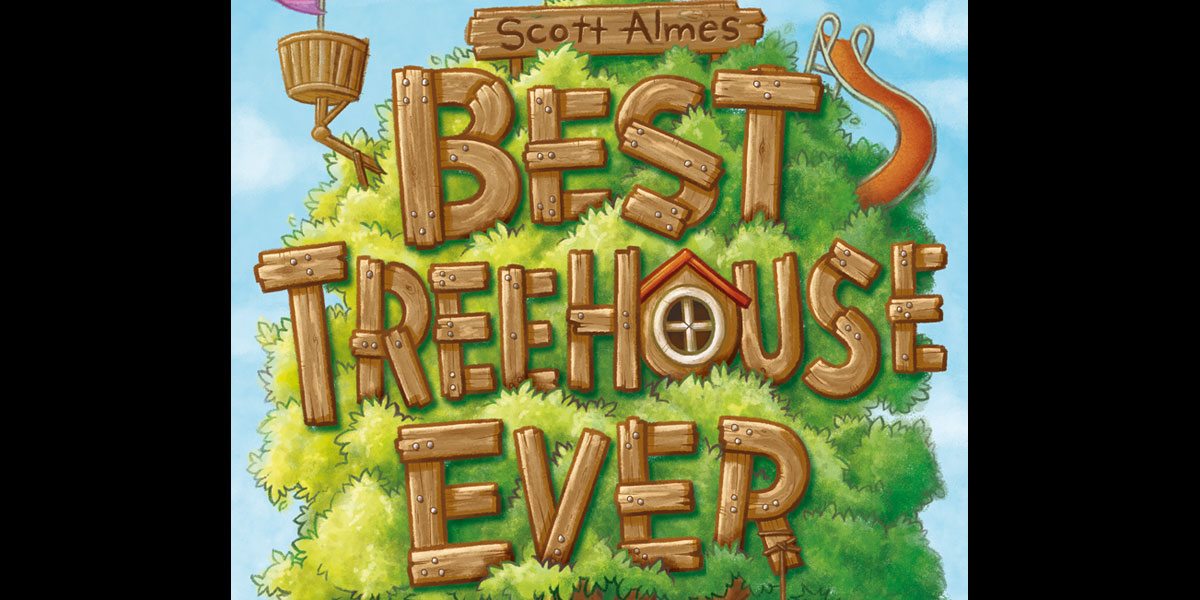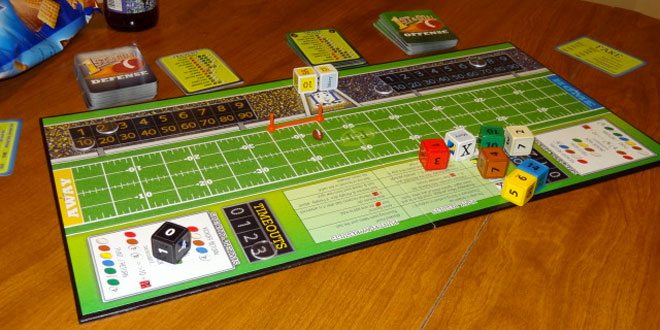
Table for Two is a series focusing on two-player board games. Today’s game is 1st and Goal, a football simulator that gets geeks like me into football. This review is modified from one originally posted in November 2012.
Okay, I know, there are plenty of geeks who love football. But for me, I’ve always been one of those people who watches the Super Bowl for the ads and the halftime show. (And, in recent years, not even for those.) 1st and Goal is a perfect substitute for sitting and watching football—instead, I get to call the plays and lead my team to sweet victory (or bitter defeat). It’s not a new game, but R&R Games just launched a Kickstarter campaign for a digital version of the game. I’ll start with how the game works, and then explain the Kickstarter down at the bottom.
At a glance: 1st and Goal is for 2 to 4 players (but really, come on, it’s two teams), ages 13 and up, and takes an hour (or a bit more). I would say that younger kids won’t have trouble learning the basic rules, though more experienced players will be better at the strategy. Thematically, it’s all about the football, so nothing inappropriate for younger audiences. 1st and Goal retails for $29.95.

Components:
- 1 game board
- 6 clear disks for tracking score and timeouts
- 1 plastic “coin” for the coin toss
- 1 football token
- 1 First Down flags marker
- 7 team dice
- 3 game dice
- 60 Offense cards
- 60 Defense cards
- 2 Fake/Kick cards
The dice are oversized plastic dice and you’ll have to apply the stickers yourself—the centers are recessed to hold the stickers. One die is the Play die, and has various icons which will indicate whether the play is broken up, if there’s a potential penalty or turnover, or if there’s a breakaway that could lead to more (or less) yardage. There are also a Referee die and a Penalty die, which will indicate whether a penalty is on the offense or defense, and how much yardage is gained or lost. There’s a black Defense die which ranges from 1 to -5, and indicates the influence of the defense on the play. Finally, there are six colored Yardage dice, each with different ranges of numbers. The plays used will determine which Yardage dice are rolled.
The football is a tiny little plastic football, but the really cool feature is that it’s magnetic. The center of the board, which shows the (somewhat narrow) football field, has some metal embedded under the surface, so the football stays where you put it. The First Down flag marker also has magnets in it so it can be stuck down on the sideline. (My flag marker was a little bent but is serviceable.) I love the little magnetic bits—I think they’re brilliant, and something that I imagine could be used in so many other games with little bits that can easily be bumped. The board also has areas to keep track of the score and timeouts, and has player aids to indicate what the various sides of the Play die mean.
The cards are nice and sturdy, but can be tough to shuffle at first until you’ve gotten them separated well. The little clear disks for marking score and timeouts work fine, but can be hard to see. It might have been nice to use some sort of larger pawn for visibility. Overall, the quality of the components is pretty nice.
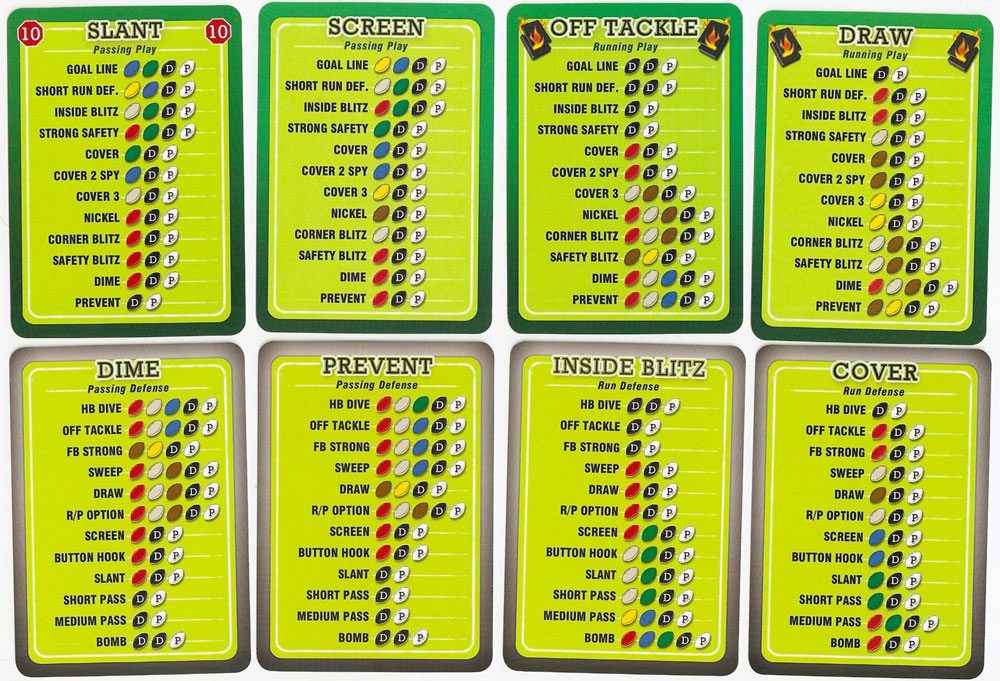
Gameplay:
(For full rules, click here.)
The players decide who will be Home and Away and sit on the appropriate side of the board. Put two clear disks next to each score section, and put disks on the “3” Timeouts marker. The Referee and Penalty dice go on the top center of the board. Flip the coin (Away calls it) and the winner decides whether to kickoff or receive. Then each player gets a Fake/Kick card and the appropriate deck of plays (offense or defense), shuffles them, and draws 8 cards.
First, there’s a kickoff. It’s just assumed it’s a good kick, and then the offense gets to return it. They can either take a touchback and start on their 20-yard line, or try to run it back, which lets them roll a certain number of dice. There’s a chance to get more than 20 yards (especially if you roll the breakaway icon) but you could also get stopped further back.
The flag marker is placed to indicate the first down, and the football is placed on the board. The board has dividing lines, and the football is moved from left to right to indicate first through fourth downs.
To play, each player selects a card from their hands and places it face down, or calls a timeout. (I’ll get to those in a minute.) The cards are revealed simultaneously, and the plays are compared. If the offense played a running play, immediately “burn” a card by discarding the top card of the Offense deck, or discarding from the hand if the deck is out. (Running plays have a “fire” icon in the top corners, and use up the game clock.)

Each Offense card lists the 12 possible Defense plays, and vice versa. You match up the name of the play, and this indicates the dice which will be rolled. You always roll the white Play die, and then some combination of Yardage and Defense dice. When the defense type matches the offensive play, typically there will be fewer (or less powerful) Yardage dice rolled. In some cases, the defense will even get to roll the Defense die twice.
First, you check the Play die to see if anything special occurs. For regular plays the “Hail” and “Mary” sides do nothing.
- “X” means the play is broken up, there is no yardage gained, and the football is moved right to indicate the next down.
- The lightning bolt indicates a breakaway: move the ball the indicated yardage (total up all the Yardage dice and the Defense die), and then everyone rolls the dice again and moves the yardage again. If the Play die shows the breakaway side, then continue again; otherwise ignore all other icons and the play ends.
- “T” means a potential turnover: move the ball the indicated yardage, and then roll the Referee die. If the “T” comes up then there’s been a turnover and the ball changes hands.
- “P” means a potential penalty: roll the Referee die and the Penalty die. If the Referee die shows a D, it’s a penalty on the Defense and they give up yardage. If it’s an O, then the penalty is on the Offense and they lose yardage. The Penalty die will show the number of yards lost — the “A” means automatic first down if the penalty was on the Defense. Unless there’s an “A,” the down isn’t changed this turn. If the Referee die shows anything other than O or D, then there is no penalty and you take whatever yardage the colored dice indicated.
After each play, you draw back up to 8 cards.
If you move past the end of the flag markers, then you get a new first down and you move the yardage marker. Fail to do so after the fourth down, and the ball changes hands: you shuffle your current hand back into the deck, and swap decks. The Offense takes the ball where it is and moves the flag marker to indicate their first down.
Timeouts: Before playing cards, you can call a timeout. This lets you either secretly pick a card back out of your discard pile and put it in your hand, or shuffle your hand into your deck to draw a new hand. Your opponent also gets to do the same.
Of course, you score by getting the ball into the endzone, which gets you six points. You can go for an extra point by rolling the Play and Referee dice—two “X”s means it’s blocked but otherwise you score an extra point. Or, you can try for a two point conversion instead by making a regular play from the 2-yard line. Finally, if you have at least one down and one card remaining, you can attempt a field goal for three points—this lets you roll a number of dice.
The half ends when the Offense runs out of cards. You can run down the clock further on a completed pass by burning an additional card from your deck, but the Defense can prevent this by calling a timeout. Finally, if the Offense has only one or two cards left in their hand and is on or past their 35-yard line, they can attempt a Hail Mary pass as the last play of the half. Roll both the Play and Referee dice: if they show “Hail” and “Mary” then a touchdown is scored.
There are a few other special rules for field goals, onside kicks, punts, and so on, but that’s the basic idea. One thing about punting/kicking is that you announce that you’re kicking, and then each player secretly chooses one side of their “Fake/Kick” card. They are revealed simultaneously, and the results determine what happens—roll dice for the kick, kick with extra yardage, run a play without the Defense die, or turnover.
Conclusion:
Like I said, I’m not a huge fan of football itself, but I’m really enjoying 1st and Goal. In fact, like the historical board games I’ve mentioned before, I think it’s the sort of board game that will actually enhance my understanding and enjoyment of the real thing. The first time I played the game (with another non-football fan), I had a lot of “aha” moments. The back of the rulebook also includes a short section explaining the various offensive and defensive plays mean, so you can learn what “FB Strong” actually means.
Granted, there’s a lot of luck involved—a lot hinges on the die rolls—but a big part of the game is predicting which type of play your opponent is going to choose, but there’s also some risk/reward balancing as well. Some plays will give you moderate yardage potential regardless of what the defense plays, but plays that can gain a lot of yardage also stand to lose a lot if you get sacked.
The rulebook says 1st and Goal is for 2 to 4 players, but if you have more than one player on a team then essentially you split Offense and Defense duties, which means only two players are actually playing at any given time. When I played this against my cousin over Thanksgiving break, my kids “assisted” us but it’s still mostly a two-player game. Also, the 60-minute play time advertised on the box may be like the 60-minute length of an actual football game. Sure, the clock gives you an hour, but the game itself takes a while longer. I imagine that after playing a few times the game will speed up, but so far it’s taken longer than that.
R & R Games also has expansion teams: you can buy a set of four teams for $15. Each team is a custom set of seven dice: the colored Yardage dice and the black Defense die. You’ll use the same types of plays, but this means that each team has its own strengths and weaknesses. Some are great at passing plays, some are good at defense. I haven’t gotten to try those yet, but I think it could make for a much more interesting game, because right now you’re basically playing against an identical team. Introducing other teams means that your strategy for picking plays changes, but it also gives the defense more information about the types of plays you might choose.
Whether you’re a true football fanatic or just a board gamer with a casual interest in the sport, 1st and Goal is worth checking out. You can order directly from R & R Games, through Amazon, or check your neighborhood game store.
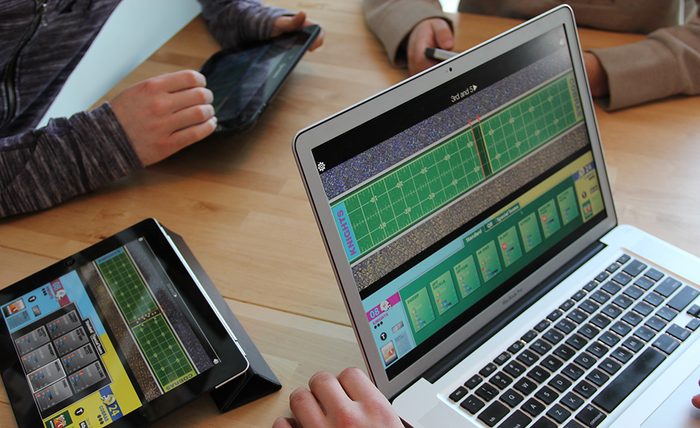
About the Kickstarter
1st & Goal has a lot of fans, and R&R Games wanted to make it possible to bring their tabletop football experience to even more fans—giving you the chance to play against opponents worldwide or get a couple of solo games against the computer. So they’ve launched a Kickstarter campaign for a digital version of the game. The plan is to make it cross-platform: iOS, Android, PC, and Mac.
The app will use the same gameplay as the tabletop version, but adds other features like customized teams, season play and championship brackets, and even house rules that players have developed over the years. The project just launched this weekend and is trying to raise $25,000 by the end of April. The pledge level for a copy of the game is $15, with various other levels that provide bonus rewards.
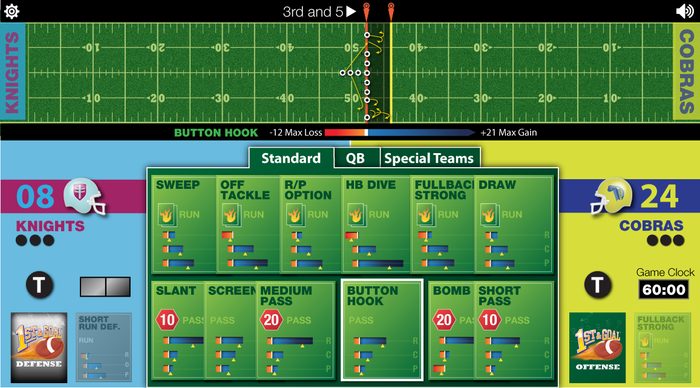
Personally, I tend to prefer analog, face-to-face tabletop gaming, so I’ll probably stick to my hard copy of 1st & Goal. But if you’re looking for a fun way to play football against faraway friends and you’ve never tried 1st and Goal, take a look at the Kickstarter project and gear up for football season!
Disclosure: GeekDad received a copy of this game at the time of the original review.



